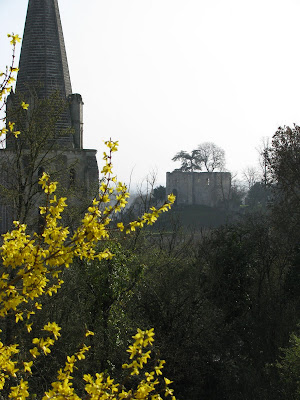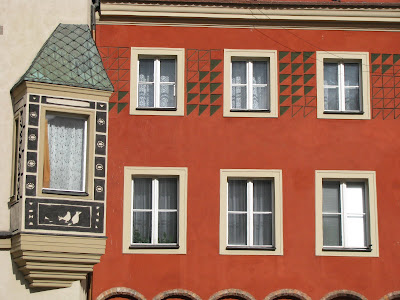Check out our video about maple syrup production which we will be using with our students. Thanks to Jillian, Joanna, and Lynne and Elizabeth for the footage.
Thursday, March 26, 2009
Tuesday, March 24, 2009
Tours to Langeais by Bike
It's finally springtime in Tours. This weeked we biked the approximately 30 kilometers from Tours to Langeais, passing through the towns of Fondettes, Luynes, St-Etienne-de-Chigny, and Cinq-Mars-la-Pile.
View Larger Map
 The donjon of Langeais.
The donjon of Langeais.
 The Chateau and cathedral of Langeais seen from above.
The Chateau and cathedral of Langeais seen from above.

 A canal runs through downtown Luynes.
A canal runs through downtown Luynes.
 Downtown Cinq-Mars-la-Pile--about 2 hours into our trek.
Downtown Cinq-Mars-la-Pile--about 2 hours into our trek.
 The "Pile" from which Cinq-Mars-la-Pile derives its name, is a 2nd century Roman construction of unknown purpose. It stands 100 ft. high, dominating the skyline of this small riverside town. Notice the ornate brick decoration.
The "Pile" from which Cinq-Mars-la-Pile derives its name, is a 2nd century Roman construction of unknown purpose. It stands 100 ft. high, dominating the skyline of this small riverside town. Notice the ornate brick decoration.
 The "Pile" from afar.
The "Pile" from afar.
 Troglodytic homes built into the limestone cliffs on the banks of the Loire between St-Etienne-de-Chigny and Cinq-Mars-la-Pile.
Troglodytic homes built into the limestone cliffs on the banks of the Loire between St-Etienne-de-Chigny and Cinq-Mars-la-Pile.
 The countryside is dotted with wildflowers.
The countryside is dotted with wildflowers.
 St-Etienne-de-Chigny has some of the most picturesque troglodytic homes in Touraine.
St-Etienne-de-Chigny has some of the most picturesque troglodytic homes in Touraine.
 Gallo-Roman aqueducts in the countryside around Fondettes.
Gallo-Roman aqueducts in the countryside around Fondettes.
 A farmhouse near Fondettes.
A farmhouse near Fondettes.
View Larger Map
 The donjon of Langeais.
The donjon of Langeais. The Chateau and cathedral of Langeais seen from above.
The Chateau and cathedral of Langeais seen from above.
 A canal runs through downtown Luynes.
A canal runs through downtown Luynes. Downtown Cinq-Mars-la-Pile--about 2 hours into our trek.
Downtown Cinq-Mars-la-Pile--about 2 hours into our trek. The "Pile" from which Cinq-Mars-la-Pile derives its name, is a 2nd century Roman construction of unknown purpose. It stands 100 ft. high, dominating the skyline of this small riverside town. Notice the ornate brick decoration.
The "Pile" from which Cinq-Mars-la-Pile derives its name, is a 2nd century Roman construction of unknown purpose. It stands 100 ft. high, dominating the skyline of this small riverside town. Notice the ornate brick decoration. The "Pile" from afar.
The "Pile" from afar. Troglodytic homes built into the limestone cliffs on the banks of the Loire between St-Etienne-de-Chigny and Cinq-Mars-la-Pile.
Troglodytic homes built into the limestone cliffs on the banks of the Loire between St-Etienne-de-Chigny and Cinq-Mars-la-Pile. The countryside is dotted with wildflowers.
The countryside is dotted with wildflowers. St-Etienne-de-Chigny has some of the most picturesque troglodytic homes in Touraine.
St-Etienne-de-Chigny has some of the most picturesque troglodytic homes in Touraine. Gallo-Roman aqueducts in the countryside around Fondettes.
Gallo-Roman aqueducts in the countryside around Fondettes. A farmhouse near Fondettes.
A farmhouse near Fondettes.
Sunday, March 8, 2009
Montpellier et Environs
 Jim and Jennifer's house.
Jim and Jennifer's house. We spent the second week of our vacation visiting Jim and Jennifer in Clermont-l'Herault, a small town near Montpellier in the Languedoc region of France. They live in a lovely house in the hills, and own the house next door, where we stayed. They took us to see all the sites in the region, including a day trip to Arles in Provence. Here are a few pictures to give you an idea of our experience.
We spent the second week of our vacation visiting Jim and Jennifer in Clermont-l'Herault, a small town near Montpellier in the Languedoc region of France. They live in a lovely house in the hills, and own the house next door, where we stayed. They took us to see all the sites in the region, including a day trip to Arles in Provence. Here are a few pictures to give you an idea of our experience. Brendan in the sun room.
Brendan in the sun room. Our guesthouse.
Our guesthouse. Trompe-l'oeil door in Pézènas. It is designed to be seen from the side.
Trompe-l'oeil door in Pézènas. It is designed to be seen from the side. Church in Saint-Gilles, near Arles.
Church in Saint-Gilles, near Arles. Relief on the church in Saint-Gilles.
Relief on the church in Saint-Gilles. From the top of the Roman coliseum in Arles.
From the top of the Roman coliseum in Arles. Brendan, Jim, and Jennifer on top of the coliseum.
Brendan, Jim, and Jennifer on top of the coliseum. Part of a Roman aqueduct that once connected Nîmes and Uzès (24 km away).
Part of a Roman aqueduct that once connected Nîmes and Uzès (24 km away). Near Lake Salagou, in the hills around Clermont-L'Herault, the soil takes on an almost purple color. The wind here is wild, and the scenery is prehistoric-- in fact we stopped to take a look at some dinosaur footprints.
Near Lake Salagou, in the hills around Clermont-L'Herault, the soil takes on an almost purple color. The wind here is wild, and the scenery is prehistoric-- in fact we stopped to take a look at some dinosaur footprints. Facades in Salasc, a small town in the hills.
Facades in Salasc, a small town in the hills. Le Pont du Diable near Saint-Guilhem-le-Désert.
Le Pont du Diable near Saint-Guilhem-le-Désert. The region is famous for this bright green glaze, which has been produced since the middle ages.
The region is famous for this bright green glaze, which has been produced since the middle ages. Saint-Guilhem-le-Désert is a small hilltop town with a magnificent church.
Saint-Guilhem-le-Désert is a small hilltop town with a magnificent church.
Monday, March 2, 2009
Poznań, Poland
All of our unfair stereotypes about Poland vanished when we arrived in Poznań. We were picturing a dreary, industrial landscape, but were surprised by beautiful pastel-painted buildings, a wonderful museum of Polish art, and delicious, cheap meals. The city's main attraction is its old market square, Stary Rynek. We visited the town hall, which has been turned into a small museum of local history. Both here and in the art museum we were dutifully followed by a gaggle of middle-aged docents, who are there to make sure you don't touch anything (or take pictures, in the case of the town hall, where the privilege costs you an extra 7 zloty). It was pretty amazing to see an entire museum dedicated to artists we'd never heard of, and artistic movements Western Europe has more or less forgotten - the museum included an excellent collection of Polish Symbolist art, something we didn't really know much about, but which is apparently finally getting its due in an exhibit at the Tate Modern in London.
We enjoyed some great food in Poznań, too. We had pierogis for lunch and Polish Jewish cuisine for dinner, and bought honey liqueur at a local food shop. Although we only spent one day here, it was definitely worth seeing.
 Ostrów Tumski, a cathedral on the east side of the city.
Ostrów Tumski, a cathedral on the east side of the city.

 One of the many open-air markets we saw.
One of the many open-air markets we saw.
 Stary Rynek, Poznań's town square.
Stary Rynek, Poznań's town square.



 Facades in Stary Rynek.
Facades in Stary Rynek.


 The Pope Crosses record each visit the Pope has made to the city (we think).
The Pope Crosses record each visit the Pope has made to the city (we think).
 One of the university buildings.
One of the university buildings.
We enjoyed some great food in Poznań, too. We had pierogis for lunch and Polish Jewish cuisine for dinner, and bought honey liqueur at a local food shop. Although we only spent one day here, it was definitely worth seeing.
 Ostrów Tumski, a cathedral on the east side of the city.
Ostrów Tumski, a cathedral on the east side of the city.
 One of the many open-air markets we saw.
One of the many open-air markets we saw. Stary Rynek, Poznań's town square.
Stary Rynek, Poznań's town square.


 Facades in Stary Rynek.
Facades in Stary Rynek.

 The Pope Crosses record each visit the Pope has made to the city (we think).
The Pope Crosses record each visit the Pope has made to the city (we think). One of the university buildings.
One of the university buildings.
Sarah and Brendan in Berlin


For our February break, we decided to go east to Berlin. We stayed in a hostel in Mitte, a neighborhood part of the former DDR, which now is home to many cool restaurants and bars. We spent 6 days exploring the city--east and west--going to museums, trying local cuisine, and taking lots of pictures. Here are a few:
 The view from our hostel room--actually just a theater, even though it looks like it should be something much scarier.
The view from our hostel room--actually just a theater, even though it looks like it should be something much scarier. The Nazi Olympic Stadium is in current use, and was modernized with a fiberglass roof in the 90s. It's a gigantic, imposing concrete structure with a sunken field. You can see the bell tower in the background.
The Nazi Olympic Stadium is in current use, and was modernized with a fiberglass roof in the 90s. It's a gigantic, imposing concrete structure with a sunken field. You can see the bell tower in the background.
 Brandenburg Tor-- the gateway between East and West Berlin.
Brandenburg Tor-- the gateway between East and West Berlin. Berlin's central cathedral, seen from a bridge over the Spree.
Berlin's central cathedral, seen from a bridge over the Spree. Inside an old brick church in Mitte.
Inside an old brick church in Mitte. Socialist-realist art on an apartment building in Mitte.
Socialist-realist art on an apartment building in Mitte. Tacheles is Berlin's largest squat--it includes gallery and concert space and is covered in graffiti inside and out.
Tacheles is Berlin's largest squat--it includes gallery and concert space and is covered in graffiti inside and out. Currywurst is the gastronomical specialty of the city... You get all the sausage, sauerkraut and fried potatoes you can eat for about 4 Euros.
Currywurst is the gastronomical specialty of the city... You get all the sausage, sauerkraut and fried potatoes you can eat for about 4 Euros. Berlin is all about the contrast of old and new(ish). The ubiquitous t.v. tower emerges from the fog behind an old church in Mitte. Bicyclists share the road with brightly-colored trams.
Berlin is all about the contrast of old and new(ish). The ubiquitous t.v. tower emerges from the fog behind an old church in Mitte. Bicyclists share the road with brightly-colored trams.
Subscribe to:
Comments (Atom)